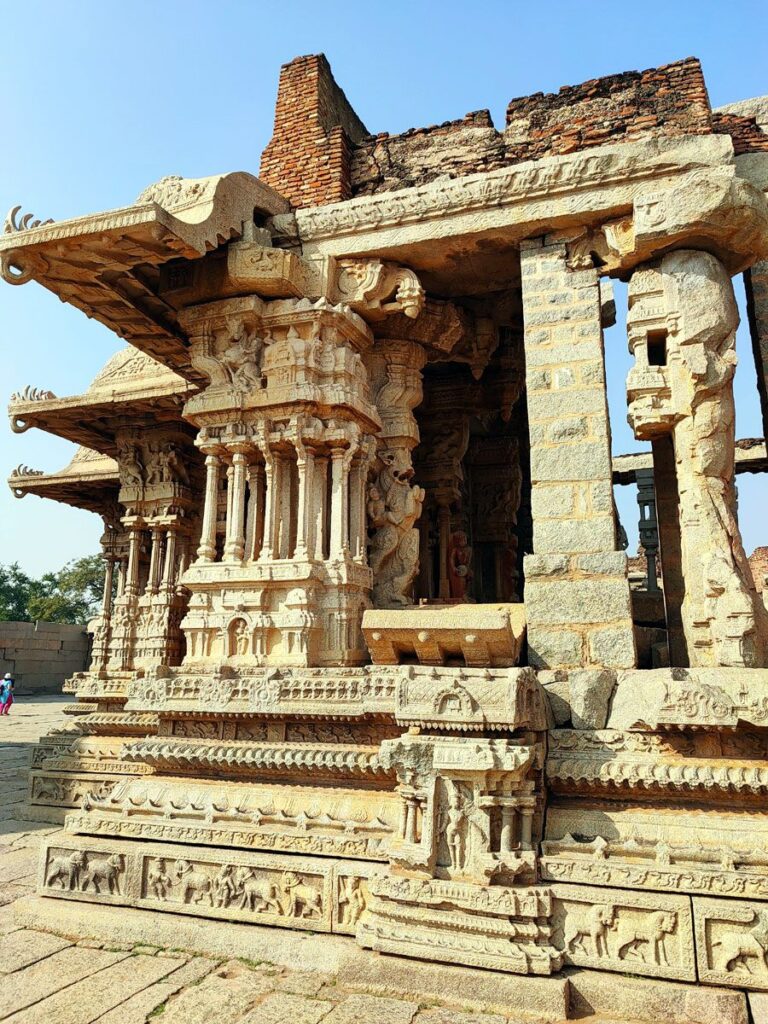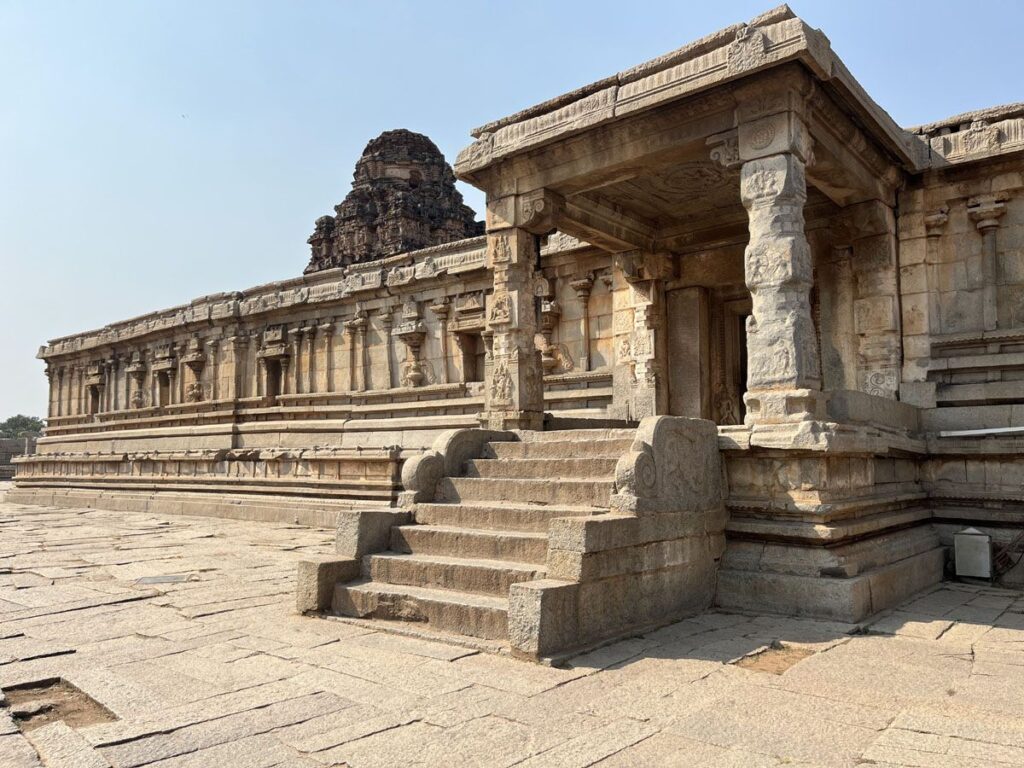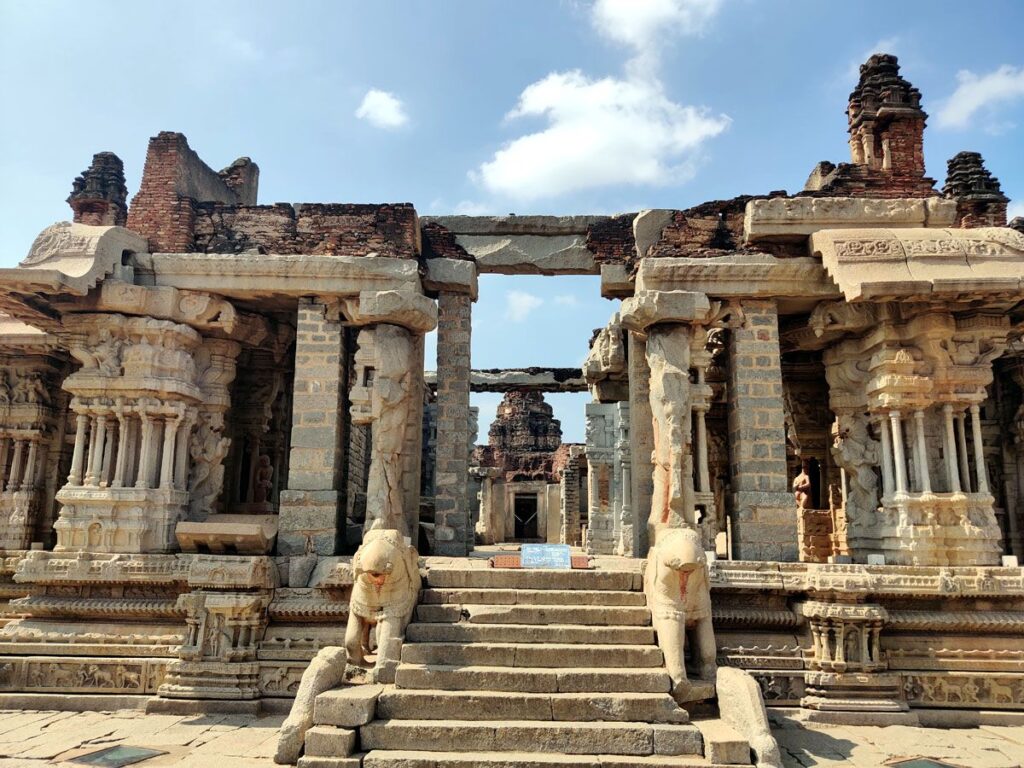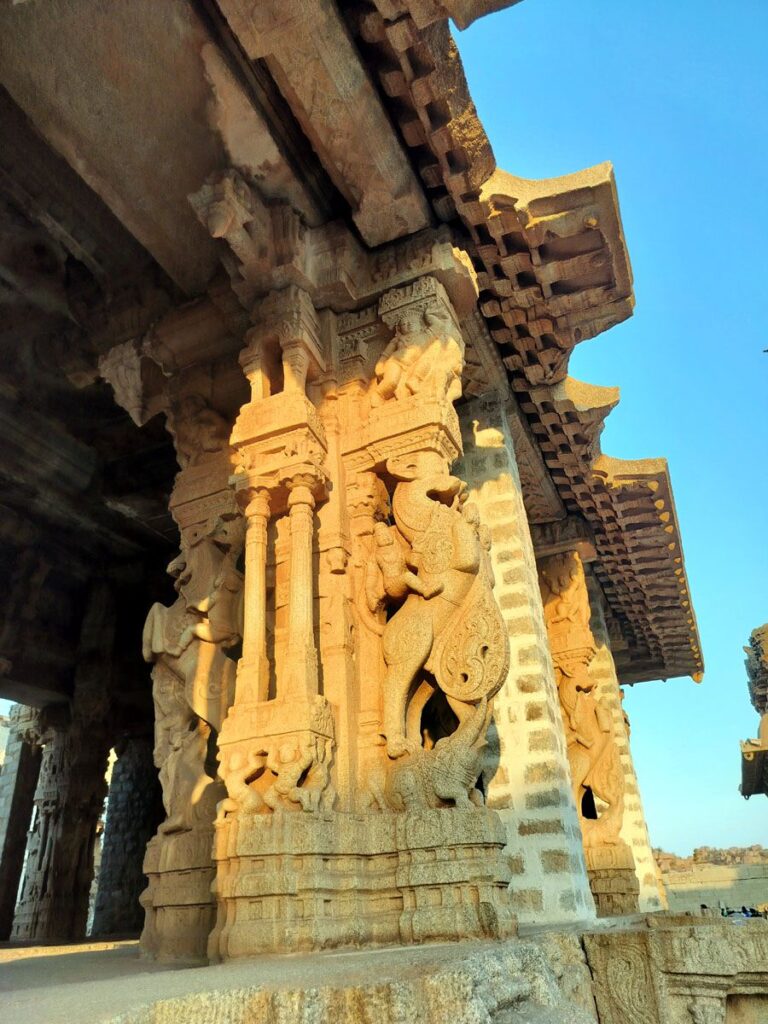Vittala Temple Hampi
The Vittala Temple in Hampi, Karnataka, is a stunning example of ancient Indian architecture and art. Built in the 15th century during the reign of the Vijayanagara Empire, it is dedicated to Lord Vitthala, a form of the Hindu god Vishnu.

Contents
- 1 Vittala Temple History:
- 2 Legend of Vittala Temple Hampi:
- 3 Significance of Vittala Temple:
- 4 Myths & Beliefs of Vittala Temple:
- 5 Vittala Temple Architecture:
- 6 Vittala Temple Hampi Timing:
- 7 Places to visit near Vittala Temple:
- 8 FAQ:
- 8.1 1. What is the significance of the Vitthala Temple?
- 8.2 2. What are the opening hours of the Vitthala Temple?
- 8.3 3. Are there any entry fees to visit the Vitthala Temple?
- 8.4 4. What are the main attractions inside the Vitthala Temple complex?
- 8.5 5. Is photography allowed inside the Vitthala Temple?
- 8.6 6. Are there any rituals or ceremonies conducted at the Vitthala Temple?
- 8.7 7. How much time does it take to explore the Vitthala Temple complex?
- 8.8 8. What are the nearby attractions or places to visit around the Vitthala Temple?
- 8.9 9. Is Hampi Bazaar within walking distance from the Vitthala Temple?
- 8.10 10. What should visitors wear when visiting the Vitthala Temple?
- 9 How to reach Vittala Temple:
Vittala Temple History:
Origins and Early Construction
- Foundation: The Vitthala Temple, also known as the Vittala Temple, was initially constructed in the 15th century during the reign of King Devaraya II (1422–1446 CE) of the Vijayanagara Empire. This period was marked by the expansion and consolidation of the empire.
- Dedication: The temple is dedicated to Lord Vitthala, a form of Lord Vishnu, worshipped primarily in Maharashtra and Karnataka. Vitthala is considered an incarnation of Vishnu, similar to Krishna.
Expansion Under Krishnadevaraya
- Krishnadevaraya’s Reign: Vittala Temple saw substantial additions and enhancements during the reign of Krishnadevaraya (1509–1529 CE), one of the most powerful and celebrated rulers of the Vijayanagara Empire. His rule is often regarded as the golden era of the empire, marked by prosperity, military success, and cultural achievements.
- Major Contributions: Krishnadevaraya added several key structures to the temple complex, including the iconic stone chariot and the magnificent Ranga Mantapa (hall). His patronage significantly enhanced the temple’s architectural and artistic grandeur.
Read More>> Muppathamman Temple Chennai

Legend of Vittala Temple Hampi:
A Grand Abode for Vishnu: The legend says the temple was built specifically as a residence for Lord Vishnu in his form as Vittala. The Vijayanagara rulers envisioned a truly magnificent dwelling for the god.
Too Grand for the Deity: However, upon seeing the extravagant and opulent temple, Lord Vishnu is said to have felt it was too grand for him. He preferred a simpler and more humble abode.
Returning to Pandharpur: According to the legend, Vishnu chose to return to his original residence in Pandharpur, which was known for its simplicity.
Significance of Vittala Temple:
Historical Significance
- Vijayanagara Empire: The temple is a testament to the grandeur and architectural prowess of the Vijayanagara Empire, which was one of the most powerful and prosperous empires in South India during the 14th to 17th centuries.
- Krishnadevaraya’s Era: The Vittala Temple’s major expansions and embellishments were carried out during the reign of Krishnadevaraya, one of the most illustrious rulers of the empire, showcasing the zenith of Vijayanagara architecture and culture.
Architectural Significance
- Dravidian Architecture: The Vitthala Temple is a quintessential example of Dravidian architecture, known for its elaborate and intricate carvings, majestic gopurams (tower gateways), and extensive use of granite.
- Stone Chariot: The temple’s iconic stone chariot is one of India’s most recognized and celebrated monuments, symbolizing the artistic and engineering skills of the period.
- Musical Pillars: The Ranga Mantapa, or main hall, features 56 musical pillars that produce different musical notes when struck, demonstrating advanced knowledge of acoustics and an extraordinary level of craftsmanship.
Cultural Significance
- Center of Art and Music: The temple was a cultural hub where various forms of art, including music and dance, flourished. The musical pillars indicate that the temple was not just a place of worship but also a center for cultural performances.
- Carvings and Sculptures: The Vittala Temple complex is adorned with detailed carvings and sculptures depicting scenes from Hindu mythology, daily life, and royal processions, providing valuable insights into the cultural and social life of the Vijayanagara period.
Religious Significance
- Dedicated to Vitthala (Vishnu): The temple is dedicated to Lord Vitthala, a form of Lord Vishnu, who is a significant deity in Hinduism. It serves as a major pilgrimage site and attracts devotees from across the country.
- Spiritual Atmosphere: Vittala Temple’s serene and sacred environment, combined with its architectural splendor, creates a profound spiritual experience for visitors and worshippers alike.
Read More>> Lingaraj Temple: Odisha’s Architectural Marvel

Myths & Beliefs of Vittala Temple:
The Disappearing Deity: One legend connected to the temple’s main idol, Vittala-Vishnu, is the story of its disappearance. There’s a belief that the original idol vanished mysteriously sometime after the temple’s construction.
The Stone Chariot: The iconic Stone Chariot within the Vittala Temple complex is itself a source of fascination and belief. Legends say the chariot is not merely a structure, but a divine chariot used by Vishnu or his consort Lakshmi to travel.
Musical Blessings: The famed musical pillars of the Ranga Mantapa are another source of belief. Tapping these pillars is said to produce musical notes, and some believe this is a way to receive blessings from the divine.
Read More>> Meenkulathi Bhagavathi Amman Temple

Vittala Temple Architecture:
Dravidian Style:
- Dominant Influence: The temple is predominantly built in the Dravidian style of architecture, which is characterized by towering gopurams (entrance gateways), pillared halls, and intricate carvings.
- Gopurams: The entrance to the Vittala Temple complex is marked by a massive gopuram adorned with ornate sculptures depicting deities, mythical creatures, and celestial beings.
Mandapa and Garbhagriha:
- Ranga Mantapa: The main hall, known as the Ranga Mantapa, is supported by intricately carved pillars arranged in multiple rows. These pillars are a highlight of the Vittala Temple and are famous for their musical properties.
- Garbhagriha: The sanctum sanctorum, or garbhagriha, houses the deity’s idol and is the focal point of worship within the temple.
Stone Chariot:
- Iconic Structure: Perhaps the most famous feature of the Vitthala Temple is the stone chariot located in the courtyard. This intricately carved chariot resembles a temple chariot and is dedicated to Garuda, the divine mount of Lord Vishnu.
- Architectural Marvel: The stone chariot is sculpted from a single piece of rock and features intricate carvings, including wheels that are capable of revolving.
Musical Pillars:
- Acoustic Marvels: The Ranga Mantapa contains a series of musical pillars, also known as SaReGaMa pillars, which produce musical tones when struck. Each pillar emits a different musical note, creating a melodic harmony that has fascinated visitors for centuries.
- Intricate Carvings: The pillars are adorned with elaborate carvings of divine beings, celestial nymphs, and mythical creatures.
Kalyana Mandapa:
- Marriage Hall: Adjacent to the main Vittala Temple complex is the Kalyana Mandapa, or marriage hall, which was used for ceremonial weddings. The hall features beautifully carved pillars and elaborate sculptures depicting wedding scenes and celestial celebrations.
Ornate Carvings:
- Divine Pantheon: The Vittala Temple walls and pillars are adorned with intricate carvings depicting scenes from Hindu mythology, including stories of gods, goddesses, and epic battles.
- Life and Culture: Additionally, the carvings offer glimpses into everyday life during the Vijayanagara period, showcasing scenes of dance, music, hunting, and royal processions.
Read More>> 5000 Years Gangeshwar Mahadev Temple

Vittala Temple Hampi Timing:
The Vittala Temple is open for visitors from 8:30 am to 5:30 pm. However, it’s important to note that:
There are no longer any regular rituals performed within the temple, as it’s an archaeological site now.
Despite the lack of rituals, the Vittala Temple remains a significant pilgrimage site for Hindus, particularly those devoted to Lord Vishnu.
Places to visit near Vittala Temple:
Hampi Bazaar
- Historic Marketplace: Hampi Bazaar, also known as Virupaksha Bazaar, is a bustling market street lined with ancient structures, shops, and eateries. It offers a fascinating insight into the vibrant life of Hampi during its heyday.
Virupaksha Temple
Hemakuta Hill
- Sacred Site: Located close to Hampi Bazaar, the Virupaksha Temple is one of the oldest and most significant temples in Hampi. Dedicated to Lord Shiva, it is believed to have been functioning uninterruptedly since its inception in the 7th century.
- Scenic Vista: Hemakuta Hill offers panoramic views of the Hampi landscape and is dotted with numerous temples, shrines, and ancient ruins. It’s an excellent spot for sunrise or sunset photography.
Lotus Mahal
- Architectural Gem: Lotus Mahal, located in the Zenana Enclosure, is an exquisite example of Indo-Islamic architecture. Its unique lotus-shaped domes and arches make it a must-visit attraction.
Elephant Stables
- Royal Quarters: The Elephant Stables are a series of domed chambers that once housed the royal elephants of the Vijayanagara Empire. The architecture reflects a blend of Hindu and Islamic styles.
Queen’s Bath
- Royal Bathing Complex: The Queen’s Bath is an elegant structure with a central pool surrounded by arched corridors and ornate balconies. It served as a bathing complex for the royal family.
Matanga Hill
- Panoramic Viewpoint: Matanga Hill is the highest point in Hampi and offers breathtaking views of the entire landscape, including the Tungabhadra River and surrounding temples and ruins.
Achyutaraya Temple
- Architectural Marvel: The Achyutaraya Temple is known for its impressive architecture and intricate carvings. It was dedicated to Lord Tiruvengalanatha, a form of Vishnu.
Tungabhadra River
- Scenic Riverside: The Tungabhadra River flows through the heart of Hampi, offering opportunities for leisurely boat rides, picnics, and relaxation along its picturesque banks.
Anegundi
- Historic Village: Anegundi, located across the Tungabhadra River, is believed to be one of the oldest inhabited places in the region. It boasts ancient temples, cave paintings, and a laid-back atmosphere.
FAQ:
1. What is the significance of the Vitthala Temple?
- The Vitthala Temple is renowned for its architectural beauty, especially the iconic stone chariot and musical pillars. It is dedicated to Lord Vitthala, a form of Lord Vishnu, and is considered a sacred pilgrimage site.
2. What are the opening hours of the Vitthala Temple?
- The temple usually opens to visitors in the early morning, around sunrise, and remains open until sunset. However, it’s advisable to check with local authorities or guides for the specific timings, as they may vary.
3. Are there any entry fees to visit the Vitthala Temple?
- Yes, there may be a nominal entry fee for visitors to enter the temple complex. The fee helps in the maintenance and preservation of the historical site.
4. What are the main attractions inside the Vitthala Temple complex?
- The main attractions include the stone chariot, musical pillars, Ranga Mantapa (main hall), temple sanctum, and various intricately carved sculptures and structures depicting scenes from Hindu mythology.
5. Is photography allowed inside the Vitthala Temple?
- Photography is usually permitted inside the temple complex, but there may be restrictions on using flash or tripods. It’s always best to check with the authorities or signage at the site for any specific rules regarding photography.
6. Are there any rituals or ceremonies conducted at the Vitthala Temple?
- Yes, the temple conducts various rituals and ceremonies throughout the day, including abhishekam (ceremonial bathing of the deity), alankara (adorning the deity), archana (chanting of hymns), and aarti (waving of lamps). Special festivals and occasions may also witness elaborate rituals.
7. How much time does it take to explore the Vitthala Temple complex?
- The time needed to explore the temple complex may vary depending on individual preferences and interests. On average, visitors typically spend a couple of hours exploring the various structures, sculptures, and experiencing the spiritual ambiance of the temple.
8. What are the nearby attractions or places to visit around the Vitthala Temple?
- Nearby attractions include Hampi Bazaar, Virupaksha Temple, Hemakuta Hill, Lotus Mahal, Elephant Stables, and Matanga Hill. These sites offer insights into Hampi’s rich history, culture, and architectural heritage.
9. Is Hampi Bazaar within walking distance from the Vitthala Temple?
- Yes, Hampi Bazaar, also known as Virupaksha Bazaar, is usually within walking distance from the Vitthala Temple. It’s a bustling market street lined with ancient structures, shops, and eateries, offering visitors a glimpse into Hampi’s vibrant past.
10. What should visitors wear when visiting the Vitthala Temple?
- Visitors are encouraged to dress modestly and respectfully when visiting the temple, covering their shoulders and knees as a mark of respect for the sacredness of the site.
How to reach Vittala Temple:
By Air:
The nearest airport to Hampi is the Jindal Vijaynagar Airport (VOV), also known as Vidyanagar Airport, located about 36 kilometers away. From the airport, you can hire a taxi or use other local transportation options to reach Hampi.
By Train:
The nearest railway station to Hampi is Hospet Junction (HPT), which is well-connected to major cities like Bangalore, Hyderabad, and Goa. From Hospet, you can take a taxi, auto-rickshaw, or bus to reach Hampi, which is approximately 13 kilometers away.
By Road:
- From Bangalore: Hampi is about 340 kilometers away from Bangalore, and the journey takes around 6-7 hours by road. You can drive or take a bus from Bangalore to Hampi. Several private and government-operated buses ply on this route.
- From Hospet: If you’re coming from Hospet, you can take a local bus or hire a taxi to reach Vittala Temple Hampi. The distance between Hospet and Hampi is approximately 13 kilometers.






